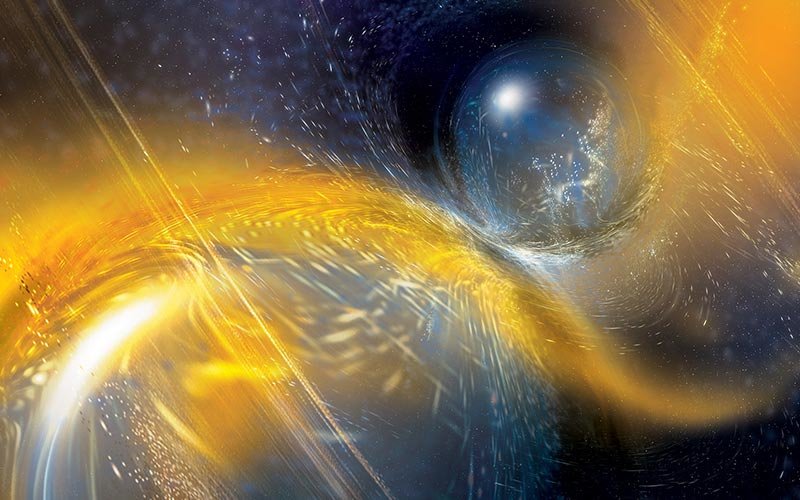
Cal State Fullerton astrophysicist Jocelyn Read knows firsthand that studying the universe is full of surprises.
For the second time, on April 25, 2019, gravitational waves — ripples in spacetime produced by accelerating masses — were detected from a cosmic collision of two neutron stars. This was no ordinary cataclysmic event 520 million light years away from Earth, Read and her colleagues across the globe uncovered.
The neutron stars combined had an unusually high mass — about 3.4 times the mass of the sun — that suggests they collided and promptly collapsed into a black hole, emitting very little light.
“When we have a new way to view the universe, we may have surprises. This new merger is one of those surprises. It looks to be from the most massive neutron-star binary, or pair of orbiting stars, ever observed,” said Read, a world expert in neutron star matter.
“We have seen radio signals from two neutron stars orbiting each other in our own galaxy, but those pairs fall within a narrow range of masses. The merging stars that produced this gravitational wave were much heavier. It’s exciting because it shows a type of neutron star merger that we didn’t know existed before.”
The LIGO Scientific Collaboration, in which Read is a member, announced the latest discovery Jan. 6 at the American Astronomical Society meeting in Honolulu, Hawaii. The new study also has been submitted for publication to The Astrophysical Journal Letters.
Read, associate professor of physics, undergraduate physics major Derek White, and Philippe Landry, a postdoctoral research associate at CSUF’s Gravitational-Wave Physics and Astronomy Center (GWPAC), all contributed to the research and are co-authors of the journal paper. Rossella Gamba, a past visiting GWPAC scholar now at the University of Jena in Germany, made key contributions to the analysis and is a member of the LIGO editorial team that compiled the journal paper.
The Laser Interferometer Gravitational-Wave Observatory (LIGO) in Livingston, Louisiana, detected the merger of two compact objects on April 25, 2019, and the European Virgo detector in Italy helped map its possible location in the sky. LIGO’s detector in Hanford, Washington, was offline at the time.
In 2015, LIGO first detected gravitational waves produced by colliding black holes, with Read, her physics colleagues Joshua Smith and Geoffrey Lovelace and their students at GWPAC contributing to the groundbreaking discovery. Since then, the international team of gravitational-wave scientists have identified dozens of binary black hole mergers. In August 2017, the first neutron star merger made history. It was the first time that both gravitational waves and light were detected from the same cosmic event, with Read and her students key contributors in the research efforts.
Neutron stars are the remnants of dying stars that undergo catastrophic explosions as they collapse at the end of their lives. “They harbor the densest matter in the known universe, denser than an atomic nucleus, so we can learn a lot about the fundamental properties of matter by observing it in its most extreme form with gravitational waves,” Landry said.
This video shows a simulation of a binary neutron star merger consistent with the source of the April 25, 2019, signal detected by the LIGO-Virgo global network of gravitational-wave detectors. The video is made up of two parts, both showing the last few orbits of the neutron stars, their collision and finally the prompt collapse of the remnant into a black hole. Credits: CoRe collaboration www.computational-relativity.org/Jena FSU
When two neutron stars spiral together, they undergo a violent merger that sends gravitational shudders through the fabric of space and time. “These gravitational waves are measured by a growing international network of observatories on Earth,” Read added.
CSUF’s Contribution to the Astrophysical Encounter
Following the detection, Read and her team began work to analyze the latest gravitational-wave signal named GW190425. Read focused on the astrophysical interpretation, while White contributed to statistical analysis of the data to verify that the signal was astrophysical in origin. Landry, who earned his doctorate in physics from the University of Guelph, Ontario, Canada, in 2017, worked on comparing the neutron stars’ measured spins to the fastest spinning neutron stars known in our galaxy. Landry and Read also helped with an analysis of the density of the neutron stars’ matter.
Read and her students are continuing to study the mysteries of dense objects in the universe.
“This new observation challenges some of our ideas about how neutron stars form,” Read shared. “Astronomers may need to reconsider how massive stars in binaries die to produce such high-mass systems.”